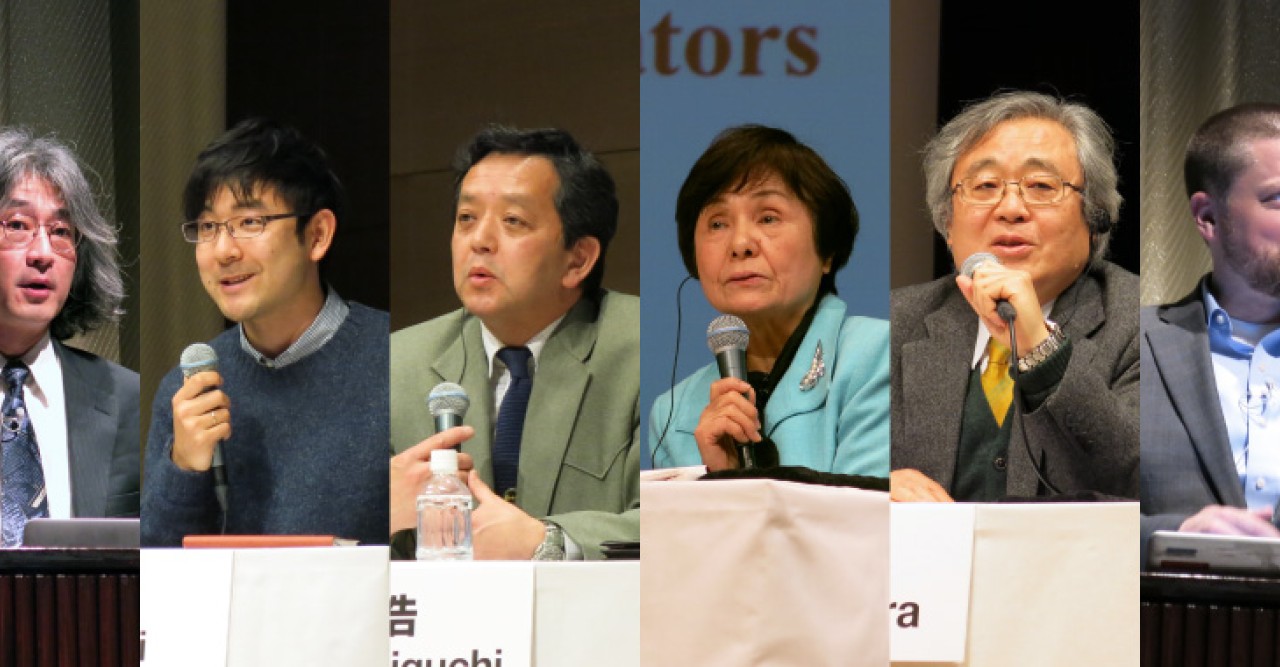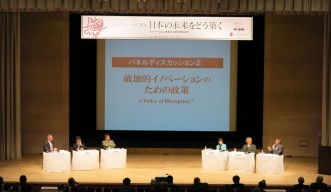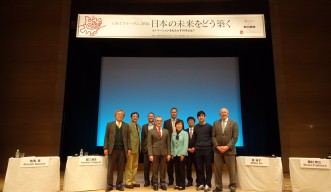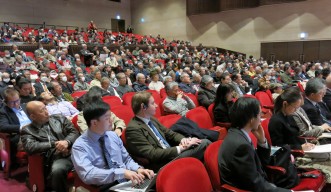Innovation – Engine for Future Economic Growth

History has shown that science and technology have brought innovation and economic growth. In the forum on March 10, 2016 organized by the Okinawa Institute of Science and Technology Graduate University (OIST) in collaboration with Nature Publishing Group and Asahi Shimbun in Tokyo, university professors, a graduate student, policy advisors, and veteran journalists each brought their individual view to dig into the issue and to delve into matters particular to Japan’s future. Diversity, communication, and capital investment appeared to be the keywords for bringing about innovation.
Following a speech by Minister of State for Okinawa and Northern Territories Affairs Aiko Shimajiri, which was delivered by Vice-Minister for Policy Coordination Kazuhiko Ishihara of the Cabinet Office, OIST President Jonathan Dorfan spoke about how OIST is training young students to become future innovators by teaching them a world view on the role of science and technology. Citing various challenges facing the human kind today including global warming, energy issues, food and water security, Dorfan underlined that science and technology is a vital tool to address these issues, and pointed to the importance of technology transfer and research funding.
In the subsequent keynote speech on basic research for innovation, Director Hitoshi Murayama of the University of Tokyo’s Kavli IPMU introduced how Japan’s unique and original research have advanced innovation and produced Nobel prize winners. He cited the discovery of X-rays that led to the development of CT scans and other medical instruments, as well as the predictions from the theory of relativity that resulted in the development of global positioning system (GPS). “In order to bring about innovation,” he said, “creativity driven by a free interaction between people from diverse backgrounds and ample funding are crucial.”
In the first panel discussion moderated by Nature’s executive editor Nick Campbell, Dorfan was joined by by Prof. Shuzo Fujimura of Tokyo Institute of Technology, Prof. Mitiko Go of Nagoya University, Dr. Yoshihiro Takiguchi of Hamamatsu Photonics K.K., and Mr. Shunji Ukai, Ph.D. student at Nagoya University, to talk about the role of research institutions in producing innovation and innovators. Unique graduate programs in Japan including that at OIST were introduced, with a consensus among the speakers that cross-disciplinary collaboration, communication which enables a conceptual exchange between people, and the mindset of students to connect to the world’s realities hold the key to innovation. It was also noted that Japan’s education system has room for improvement.
The second part of the forum opened with a talk on disruptive innovation by Dr. David Sundahl, a senior research fellow at Clayton Christensen Institute. “Technological progress grows faster than we can absorb,” Sundahl said, explaining that big companies that thrive on existing systems tend to overlook disruptive innovation, which allows people to have access to technologies that previously required expertise.
In the second panel discussion moderated by Nature’s Asia-Pacific correspondent David Cyranoski, panelists including Sundahl, Fujimura, Go, Takiguchi, and Prof. Atsushi Sunami of National Graduate Institute for Policy Studies spoke of a policy of disruption. Here, three different viewpoints from the government, the industry, and the academia were presented to discuss ways to transfer research into innovation. Citing the recent approval by Japanese Prime Minister Shinzo Abe’s cabinet on the nation’s fifth science and technology basic policy for the next five years starting in April 2016, the speakers stressed of the importance of systematic changes in Japan to allow private-sector capital investment in academic research and to diversify workforce, including better utilization of an enormous resource of women in the country.
The panel discussions were each followed by lively Q&A sessions with the audience, in which notably young graduate students raised questions ranging from how to cultivate an atmosphere of innovation in Japan, to which fields to invest, to how to encourage scientists to have an entrepreneurial spirit.
In closing, Campbell spoke about diversity, communication and capital investment as key topics to cultivate innovation in Japan. Here, diversity includes not just gender and nationality, but also subject area and way of thinking. Communication was perceived as essential in breaking down barriers of diversified groups and academic barriers of institutions. Capital investment by both the government and the industry in the right way was viewed as essential to drive innovation. “Japan has the ability, resources, and people to innovate,” he said. “All we need to do is to get things on the right track.”
For press enquiries:
Press Inquiry Form
















